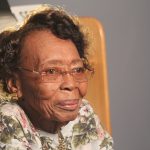
My Black History after-hours hobby, moonlighting gig and weekend obsession is taking over. What was an occasional Saturday and Sunday fascination has morphed into a 24/7/365 fixation. It’s a good addiction though. To engage in meaningful work that endures for generations is not a bad thing.
When did the script flip and the channel switch in a 20+ year journalism career spent asking what, why, who and where questions? At some point, the train I rode — confident about its destination to an on-air news job in a larger city — jumped tracks. How it happened is something I’m thinking about.

Pictured: Mr. Jenkins’ gas station and auto repair shop in Newtown.

Pictured: Booker Elementary School third grade teacher Mamie Faulk.
The Newtown community of my youth was filled with African American teachers, preachers, nurses, day laborers, dentists and many Black small business owners. I was enamored with educators such as Quessie Hall, Mamie Faulk and Jean Crayton. I interviewed Mrs. Hall about her life on weekends. She told amusing stories about her mentor, Mrs. Emma E. Booker. History was my favorite subject at Brookside Middle School. Social studies teacher Jerry Brookbank was a good guy who recognized my keen interest and gave me gift books about U.S. presidents. From middle school to high school, I watched national political conventions way past my bedtime.
My mother and aunt attended historically Black colleges during Jim Crow segregation, Talladega College in Alabama and Kentucky State University in Frankfort. In photos, the sisters are well-dressed and surrounded by friends against a backdrop of historic campus buildings. Some of their books were left at our house. I picked up one entitled, “Black Voices: An Anthology of Afro-American Literature.” Inside were essays, poetry and autobiographies about Black life. I devoured the works of Langston Hughes, James Baldwin, W. E. B. DuBois, Richard Wright and their contemporaries.


Pictured: Booker Elementary School third grade teacher Mamie Faulk.



Pictured: At top, Oldham’s mother on the campus of Kentucky State University. At bottom, Oldham’s mother’s classmates on the Kentucky State University campus. It’s winter!




Pictured from top: Oldham with Dr. Larry E. Rivers, Fort Valley State’s eighth president and a preeminent history scholar. At middle, Rivers is featured on a TV spot. At right, freshman orientation at Fort Valley State University.
The date, time and place of my career transformation from journalism to marketing to historic preservation aren’t apparent. No single or several incidents pointed me in the preservation direction. What seems to have happened is an embrace of the past and present — the culture, creativity and heritage that were inherently a part of my life. The people met during this journey of discovery pushed me along, and I eagerly, willingly, without reservation or hesitation participated in the exploration of a resilient, courageous, determined group of people who never took “no” as the final say and always looked for ways to survive.
Today, I write, post, pitch, present, launch and promote Newtown history relentlessly because it’s powerful and fills a gap. An encounter with the stories of Black folk touch, change and uplift. Newtown Alive and SAACC are a melding of the jobs I’ve held and an amalgamation of many experiences.
I saw the confidence and the comportment of HBCU graduates who became career climbers. An understanding about history made a huge difference in their lives.
History did the same for me! There’s a swag that comes with it, a certain assurance. I’m convinced that if community children are provided encounters with history and historymakers, they’d experience this “Aha!” transformation too. In this era of Diversity, Equity and Inclusion, history cannot be overlooked. Grasping it promotes pride in place, confidence and the words stamped in Newtown Alive’s logo: Courage. Dignity. Determination.

